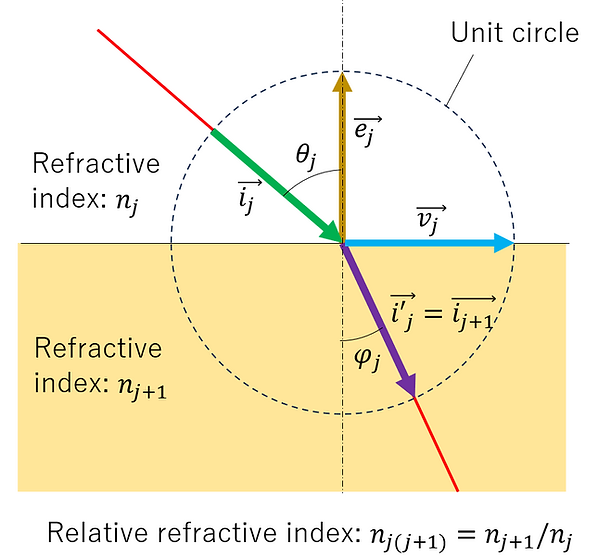Vector representation of reflection and refraction of light at material interfaces
Expressing the reflection of light at the interface of a material and the refraction of light based on Snell's law as vectors is extremely useful when dealing geometrically with the propagation of light. Here, we will derive it.
-
Vector representation of reflection at material interfaces
Each direction vector is defined as follows.

where:
Vector i: Direction vector of incident light
Vector i': Direction vector of reflected light
Vector e: Normal vector of the reflecting surface
The absolute values of all these are defined as 1.
In this case, k can be expressed as follows, where k is a positive real number.

Transforming this into the formula,

Squaring both sides,

Since the absolute value of each direction vector and normal vector is 1,

By substituting this into ①', we finally get the following equation.

Next, we will show how to calculate the direction vector of a ray after it has reflected off multiple boundary surfaces. The reflection off the j-th boundary surface is illustrated as follows:

As shown in the figure, the light reflected from the jth boundary surface becomes incident light on the next surface, so by using the derivation result obtained in ②, the following recurrence formula can be obtained, and the direction vector of the light ray after reflecting off multiple reflecting surfaces can be finally determined.

Here, the components of each vector are set as follows:

In this case, ③ can be expressed as follows:

-
Vector representation of refraction at material interfaces
Define a direction vector as shown in the following diagram.

where:
Vector i: Direction vector of incident light
Vector i': direction vector of transmitted light
Vector e: Normal vector of material interface
Vector v: A direction vector parallel to the material interface and in the same plane as the incident and transmitted light
The absolute values of all of these are set to 1.
In this case, the relationship between the vectors can be described as follows:

Here, ① represents Snell's law.
From ①,

Substituting ② and ③ into this,

Next, substitute ① and ③ into ⑤,

Substituting ④ into this,

By substituting ①' and ② into this, we finally obtain the following equation.

Next, let us consider the case where light passes through multiple boundary surfaces. The refraction at the j-th boundary surface is illustrated as follows:

As shown in the figure, the light transmitted through the jth boundary surface becomes the light incident on the next surface. Therefore, using the derivation result obtained in ⑥, the following recurrence formula is obtained, and the direction vector of the light ray after passing through multiple transmitting surfaces can be finally determined.

Here, the components of each vector are set as follows:

In this case, ⑦ can be expressed as follows:
